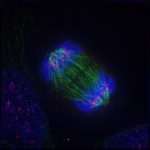Definition
noun
The stage in the first meiotic division after anaphase I, and identified by the complete movement and separation of the paired homologous chromosomes to the opposite ends of the cell
Supplement
Meiosis is a specialized form of cell division that ultimately gives rise to non-identical sex cells. There are two successive nuclear divisions: meiosis I and meiosis II. Each of them has four major phases. These are prophase, metaphase, anaphase and telophase. Each of these phases is designated as I or II depending where it occurs, i.e. in meiosis I or in meiosis II.
Telophase I is the stage in meiosis I that follows after anaphase I. In anaphase I, the paired homologous chromosomes begin to separate from each other and move towards the opposite ends of the cell. This occurs as the kinetochore microtubules shorten, pulling and separating the paired chromosomes from each other. Telophase I is that phase when the chromosomes have finished moving to opposite ends of the cell. This will then be followed by cytokinesis producing two daughter cells.
After cytokinesis, the two daughter cells would have genetically different chromosomes after meiosis I. Depending on the species, the next stage may be an interkinesis (i.e. a brief phase prior to the second meiotic division) or the daughter cells would immediately proceed to prophase II of meiosis II.
Meiotic telophase I is different from mitotic telophase in a way that the paired chromosomes are the ones that separate from each other in meiotic telophase I and not the sister chromatids as in mitotic telophase. Thus, after meiosis I, each cell would have a haploid set of chromosomes but each chromosome would still be comprised of two sister chromatids.
See also:
- meiosis I
- telophase
- homologous chromosome
- cytokinesis




